 Written by Hulet Smith, OT
Written by Hulet Smith, OT
When someone chooses to age in place, remaining at home for as long as possible surrounded by the things that mean the most to them, supplementary aids can help them maintain their independence. If balance is an issue that puts your aging parent at a greater risk of falling, a walker can help them remain independent and safely stay in their home longer. As occupational therapists, we know this can be a daunting challenge, so we've made a guide with everything you need to know about choosing the best walker for seniors and our best products to fit your exact needs.
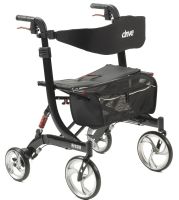 | Drive Medical Nitro HD Rollator View Product |
 | Drive Medical Go-Lite Bariatric Steel Rollator View Product |
Although sometimes people do use the two terms interchangeably, there are distinct differences. A walker is a frame with handles and legs, and it needs to be lifted for movement. A rollator has wheels and is pushed; it includes hand-operated brakes and could include a seat for use while resting. In our experience, a walker provides a slower-paced experience than a rollator.
 | Comodita Uno All Terrain Rollator Walker with Orthopedic Seat and Ergonomic Backrest View Product |
Yes, some walkers have wheels. Standard walkers are simple and lightweight and do not have wheels. Users must have the strength to pick up the walker and move it forward with each step. We use it as the most stable solution for people who need a little help. There are two-wheeled walkers, which deliver easier mobility, for users who don’t need quite as much support but aren’t stable enough to use a rollator. Both types of walkers are height adjustable, with folding and non-folding options available.
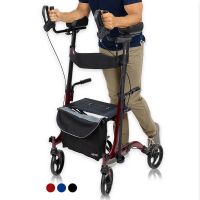 | Upright Rollator / Rollator Walker with Seat and Forearm Supports View Product |
The types of walkers are standard, 2-wheeled, and hemi. Below we give you the breakdown of each type of walker and sprinkle in our top-selling products.
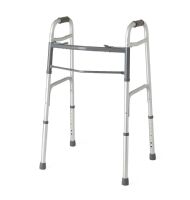 | Two-Button Folding Walkers Without Wheels by Medline View Product |
A standard walker has no wheels and must be completely lifted off the ground with every forward step. If a user can’t bear weight on one or both legs but is mobile enough to not need a wheelchair, a standard walker is an appropriate choice. We agree these walkers are best for indoor use and are especially useful for patients who are recovering or rehabbing as a result of a hip or leg injury or surgery.
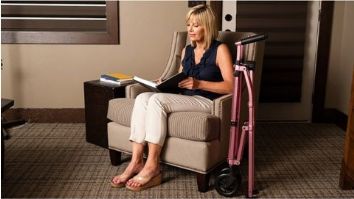 | EZ Fold-N-Go Height Adjustable Lightweight Travel Walker View Product |
Two-wheeled walkers are a good choice for people who want extra stability, especially while walking on different surfaces. Because they aren’t lifted off the ground with each step, rolling walkers facilitate a more normal walking pattern. The combination of the front wheels and the back legs makes this style easier to maneuver on uneven surfaces inside or outdoors.
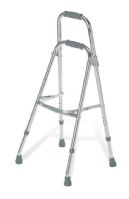 | Adult Hemi One Arm Walker / Sidestepper by Medline View Product |
A hemi walker is smaller than a standard walker, with four legs and a simple frame. It can be held with one hand and it provides good stability for people who have weakness in one leg or limited dexterity and strength in one arm. It has a simple design and economical price point, which we understand makes it popular for people who don’t want their pace to be limited by standard walkers.
Some walkers are designed to meet the needs of certain health conditions. Here are some walkers that can help you address specific conditions.
| Kaye Posture Control Posterior Walker View Product |
Posterior walkers provide stability while walking, and are especially helpful for users who are seeking to achieve more mobility and better balance. This kind of walker positions the user in a way that promotes good posture alignment control. In our experience, they also provide for a faster walking pace than anterior models.
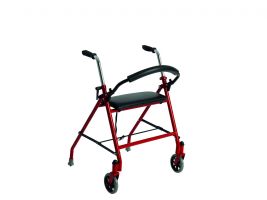 | Drive Medical Two Wheeled Walker with Seat View Product |
Walking with a walker can get tiring, and if there isn’t a safe and secure place to stop and take a rest, there are walkers with fold-down seats to accommodate the user wherever and whenever a rest is needed. Some walkers come with a seat included, but we offer an attachable seat that can be purchased as an optional accessory for most walkers.
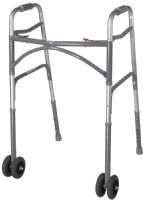 | Drive Medical Two Button Bariatric Aluminum Folding Walker with Wheels View Product |
With a wide, extra-sturdy frame, a bariatric walker might have two wheels or four, and can safely accommodate users weighing up to 600 pounds.
Using a stand assist walker, users can pull themselves up from a seated position using the lower hand grips, and as they build their upper body strength, they can move on to use the upper-level grips. As a mobility aid, once users have pulled themselves up, they can then lean on the upper hand grips and utilize it as a walker.
Here are some unique walkers that can help you tackle specific terrains.
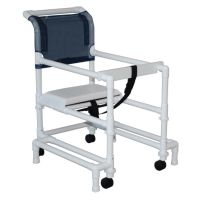 | Lumex Freedom PVC Walker with Seat and Safety Belt View Product |
Made of rust and corrosion-resistant PVC, a shower walker makes it possible for people with mobility challenges to maintain their independence by getting themselves to the shower or bathtub, and into and out of the bathing area with assistance.
These walkers are lightweight and durable, with big tires that provide stable support while gliding easily over outdoor terrain like sand, sleet, or snow.
.jpg&newwidth=365&maxheight=200) | Aqua Creek Aqua Walker View Product |
Aqua walkers allow users to be supported in a comfortable upright position while moving in the pool. With casters and wheels to move freely across the bottom of the pool, these walkers are built to stand up to rust and corrosion. We know these walkers improve the experience of those utilizing hydrotherapy for their rehabilitation journeys.
The best thing about the seat feature is to provide a place to sit and rest for a bit should fatigue strike while you are walking. If you will be using your walker inside at home, you probably won’t need a walker with a seat, but if you plan to be out and about, it is a convenient safety feature.
Standard walkers accommodate users up to 400 pounds, while bariatric walkers have a weight capacity of up to 1000 pounds.
One of the features that people appreciate most about walkers is the easy foldability of these lightweight mobility aids. They are easy to fit into a car trunk for transport and fold up for storage at home when not in use.
Most walkers come with plastic hand grips, and you can get replacements for them when they wear out. However, we know plastic isn’t the most comfortable material for your hands, and if you’re going to be relying on your walker a lot, it makes sense to consider choosing more comfortable replacement grips.
Walkers come in several sizes to accommodate different body types, and they are easily adjustable within the range of the frame size.
Measure from the crease in your wrist to the floor to determine the correct handle height. It’s recommended that you get a walker that adjusts at least one inch higher and lower than that measurement so there is room for any necessary adjustment.
An institutional walker is used to maneuver easily in confined spaces. Made of health-grade PVC material, in our experience, it’s a good choice for ambulatory patients.
We do not give insurance advice. However, if your doctor determines the walker is medically necessary, Medicare coverage for durable medical equipment applies.
Grip the handles on both sides of the walker and move the walker forward a short distance. Step first with your weaker leg, putting your weight on the palms of your hands. Take a step with your stronger leg, keeping your feet within the walker frame. Look up to watch where you’re headed, not down at your feet.
You can purchase a walker on your own, but if you have a prescription, it should be covered by insurance as durable medical equipment.
When partial support of body weight is needed, when more balance stability than a can provide is required, and when the user has the upper body strength to lift the walker and set it down while stepping forward.
It depends on your situation. A cane is an appropriate choice if mobility issues are affecting one side of the body, while walkers are better for weakness or pain located in both legs.
Independence is greatly tied to one’s ability to get around without assistance. The main goal of successfully aging in place is to maintain as much independence as possible for as long as possible. For people who struggle with balance or leg strength issues, standing and walking could make them a fall risk, greatly reducing mobility. A walker is a convenient, lightweight, user-friendly device that can reduce that risk, improving mobility and having a direct and positive impact on a patient’s quality of life and independent ability to accomplish daily activities.
We understand the user’s balance, upper body strength, and diagnosis all play a part in choosing the walker that will help them most in comfortably and safely maintaining their mobility. We hope this comprehensive article helped answer your questions so you can make the most informed choice when you buy.
Both walkers and rollators help people remain mobile and mitigate the risk of a fall. If you're looking for a rollator, check out our article on the 5 Best Rollators.

Co-founder/CEO of Rehabmart, Pediatric Occupational Therapist, husband, and father. Passionate about connecting special needs kids with superb nutrition, sensory integration, and complementary health strategies. Excited about Rehabmart's mission to become the premier online educational platform which empowers caregivers by spotlighting innovative devices and interventions to achieve optimal patient response and recovery.